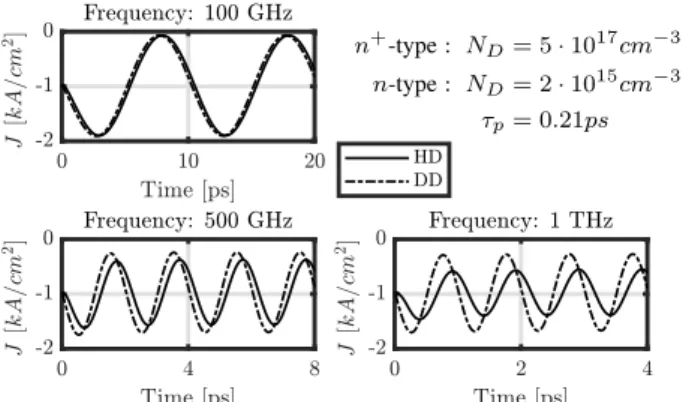Research Collection
Other Conference Item
Frequency Limit of the Drift-Diffusion-Model for Semiconductor Simulations and its Transition to the Boltzmann Model
Author(s):
Ehrengruber, Till; Güngör, Arif Can; Jentner, Kaja; Smajic, Jasmin; Leuthold, Juerg Publication Date:
2020-11-16 Permanent Link:
https://doi.org/10.3929/ethz-b-000459761
Originally published in:
http://doi.org/10.5281/ZENODO.4309129
Rights / License:
In Copyright - Non-Commercial Use Permitted
This page was generated automatically upon download from the ETH Zurich Research Collection. For more information please consult the Terms of use.
ETH Library
4(d) 1
Frequency Limit of the Drift-Diffusion-Model for Semiconductor Simulations and its Transition to the Boltzmann Model
Till Ehrengruber
1, Arif Can Gungor
1, Kaja Jentner
1, Jasmin Smajic
1, and Juerg Leuthold
11Institute of Electromagnetic Fields (IEF), ETH Z¨urich, Switzerland
Abstract—With ever increasing transfer speeds in electric communication systems, the operating frequencies of semiconductor devices reach the limit at which the underlying assumptions of the presently widely used Drift-Diffusion-Model (DDM) become invalid. For sufficiently high source frequency, the corresponding oscillation period becomes comparable to the (momentum) relaxation time. Consequently, the effect of the charge carriers’ inertia cannot be neglected anymore and more sophisticated models are required. In this work, the said effect is investigated by comparison of the DDM with the Hydrodynamic Model (HDM) and the solution of the highly non-linear set of partial differential equations by means of the Discontinuous Galerkin (DG) method is given. The results show that for frequencies above 100 GHz, modeling semiconductor devices by DDM leads to an overestimation of the current density, which also implies that for high frequency semiconductor simulations where Maxwell’s equations are coupled with semiconductor models (e.g. Scanning Microwave Microscopy (SMM), THz devices), employment of HDM is required for accurate results.
Index Terms—Drift-Diffusion, Boltzmann Transport equation, Maxwell Equations, Discontinuous Galerkin
I. PHYSICAL MODEL AND DISCRETIZATION
The description of the electromagnetic behavior of semiconductors requires the simultaneous simulation of both transport and electromagnetic interaction of the charge carriers. Based on moment expansions of the Boltzmann Transport equation, charge transport models with increasing degree of accuracy can be obtained, and the resulting set of equations for HDM are written as follows[1][2]:
∂
∂tn+∇x·(n~v) = 0 (1)
∂
∂t npx
+∇x·(npx~v) +∇(nkBT)−n ~F =−npx
τp (2)
∂
∂t(nw) +∇x·((w+kBT)n~v−κ∇T)−n~v·F~ =−n(w−wτ 0)
w
(3) wherenis the free electron concentration,~vthe mean velocity,
~
pthe momentum, T~ the carrier temperature, F~ the force on the carriers, w the mean kinetic energy and κ the thermal conductivity. For the momentum and energy relaxation times, τp and τw respectively, the analytical model after [3] is used. Transient electromagnetic simulation is performed using Maxwell’s equations:
∇ ×E~ =−µ∂ ~H
∂t , and ∇ ×H~ =∂ ~E
∂t +J~ (4), (5) and the coupling between HDM and Maxwell solver is ensured through the forceF~ =−q(E~+~v×B)~ exerted on the electrons and the current densityJ~=−qn~v.
First, DG method is utilized to solve (4) and (5) in time domain[4], and the forces acting on carriers at each time step is computed. Afterwards, the transport equations, either DDM or HDM are solved for the respective time step, again employing a DG approach[5].
II. RESULTS& DISCUSSION
We have developed stand-alone HDM and DDM solvers to simulate a 1µm long “n+nn+-diode” made of Silicon.
Our preliminary results with a voltage excitation ϕBias(t) = 0.1(1 +sin(2πf t))V, where the temperature is artificially set to TL and relaxation times are constants, show that with increasing frequency the current is attenuated and a phase shift between the excitation and the induced current occurs.
n+-type: ND= 5·1017cm−3 n-type: ND= 2·1015cm−3
τp= 0.21ps
Fig. 1: Current densities inn+nn+-diode simulated using DDM and HDM at varying frequencies. (preliminary quasi-static results)
The obtained results show that for simulating semiconductors at frequencies above 100 GHz to deal with applications such as SMM[6][7] or device characterization, the proposed coupled Maxwell-HDM solver provides considerably higher accuracy. The time domain SMM analysis, which couples Maxwell’s equations and semiconductor physics at high frequencies, will be presented in detail at the conference and in the subsequent extended paper.
ACKNOWLEDGMENT
The work presented has received funding from the European Union Horizon H2020 Program (H2020-NMBP-07-2017) under grant agreement MMAMA No. 761036.
REFERENCES
[1] K. Blotekjaer, “Transport equations for electrons in two-valley semiconductors,”IEEE Transactions on Electron Devices, Jan 1970.
[2] T. Ehrengruber, “Time-domain poisson-boltzmann solver for semiconductor device simulations,”MSc thesis, ETH Zurich, 2019, June.
[3] G. Baccarani and M.R. Wordeman, “An investigation of steady-state velocity overshoot in silicon,” Solid-State Electronics, 1985.
[4] J.M. Jin,The Finite Element Method in Electromagnetics (Wiley - IEEE), Wiley-IEEE Press, 2014.
[5] B. Cockburn and C.W. Shu, “Runge–kutta discontinuous galerkin methods for convection-dominated problems,” Journal of Scientific Computing, vol. 16, no. 3, pp. 173–261, Sep 2001.
[6] J. Hoffmann, G. Gramse, J. Niegemann, M. Zeier, and F. Kienberger,
“Measuring low loss dielectric substrates with scanning probe microscopes,” Applied Physics Letters, vol. 105, no. 1, July 2014.
[7] A.C. Gungor, J. Smajic, F. Moro, and J. Leuthold, “Time-domain coupled full maxwell- and drift-diffusion-solver for simulating scanning microwave microscopy of semiconductors,” 2019 Progress in Electromagnetics Research Symposium (PIERS), Rome, Italy, June 2019.
